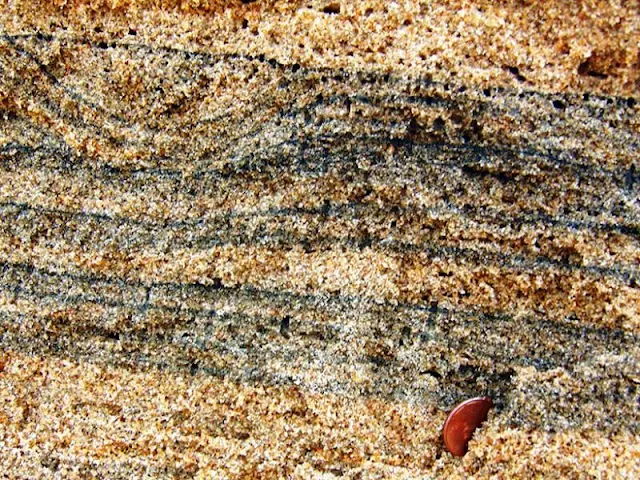Bacteria Preserve Record of Earth's Magnetic Fields
 |
| Magnetic minerals, such as the dark stripes of magnetite seen here in beach sand in India, can form layers in sediments. Credit: Mark A. Wilson via Wikimedia |
Tiny yet stable magnetized particles created by microbes long ago could help scientists better determine the strength and orientation of ancient magnetic fields.
In the waters of a prehistoric ocean, a minuscule bacterium swims back and forth, seeking food. As it does so, it leaves tiny metallic particles swirling in its wake—some already present in the water column, some excreted as the bacteria’s by-products. As the water churns from the motion of other bacteria, some of these particles—magnetic ones—attract each another, coalescing into larger, but still tiny, magnetized crystals of magnetite, goethite, hematite, and other minerals. These iron-rich crystals drift slowly downward to land on the ancient seabed, aligning with the Earth’s magnetic field as they’re buried by other sediment and eventually locked into place.
A scene much like this has unfolded again recently in a glass experimental vessel holding bacteria-filled water in a Russian laboratory. A team of scientists was curious to see how large the crystals could grow—and whether they could become substantial enough to maintain a stable magnetic orientation over millions, or even billions, of years.
“It’s bacteria that are taken from nature, normal groundwater bacteria,” said Alexandra Abrajevitch, a paleomagnetist at the Institute of Tectonics and Geophysics of the Russian Academy of Sciences in Khabarovsk, Russia, and lead author on the study. The scientists seeded the vessel of water with iron, food, and sand. Then, they waited.
Two years later, when the team looked at the reddish sludge that had formed at the bottom of their experiment, they found that the sample contained large crystals of magnetite and goethite. These are stable minerals, capable of carrying a magnetic signature over long periods of time. The team also found lepidocrocite, a magnetically unstable mineral that can transform into more stable forms over time.
In ancient waters, large particles recorded the direction of the Earth’s magnetic field when they settled on the seabed. Most of the stable particles aligned with the Earth’s magnetic field. Sediment settled on top of them, holding them in place. The different layers in sedimentary rock provide a continuous timeline of the shifting strength and direction of the magnetic field over time—“almost like a barcode,” according to David Heslop, a geophysicist at the Australian National University in Canberra, Australia, who was not involved with the new study.
Too Small to Be Useful?
Scientists have known for decades that sedimentary rock captures a record of the Earth’s magnetic field. But if the new findings published on 13 June are correct, they shed light on the way in which many of Earth’s rocks became magnetic, according to Heslop. Researchers had known that magnetic particles could be generated by erosion from iron-rich minerals or the remains of magnetotactic bacteria that create chains of magnetized particles in their bodies to help them navigate. But even though scientists can easily determine whether a rock is magnetic or not, definitively finding the cause of that magnetism—a necessary step if scientists are to glean useful information about Earth’s magnetic history—is much more difficult.
If the common bacteria in the experiment could generate stable magnetic particles, he said, a similar process could have been happening throughout Earth’s oceans, rivers, and lakes farther back in time than scientists have even looked, back when microbes first became abundant.
Researchers have been searching for these bacterially generated particles for some time, but past studies have found mostly tiny, unstable, microbe-made magnetized particles. Those smallest particles would simply be too tiny to hold a magnetic direction for long.
Heslop explained that when a magnetic particle is too small, a tiny amount of heat can cause its magnetic field to change orientation. The poles of such particles jump in all directions multiple times a second at room temperature. Longer particles would be much more magnetically stable and therefore useful to scientists who want to study what the Earth was like millions of years ago. However, researchers had no proof that bacteria could produce them.
Because there was no proof that they could be stable, the particles were dismissed as a potential data source. But the authors of the new study say that prior researchers didn’t wait long enough for the particles to mature and grow to their full size.
Heslop expects that with this new knowledge in hand, scientists will be able to scan more rocks with better accuracy to find the direction of Earth’s ancient magnetic field and to determine the strength of that magnetic field as well. Similar data have been used to track continental drift and discover more about flips and other distortions in the magnetic field similar to those that could disrupt our communications and mapping satellites in the future.
Finding the Strength
Scientists have historically had trouble researching the strength of the Earth’s ancient magnetic field. Magnetic minerals from different sources and of different sizes vary in how readily they will align with a field, Heslop said. When researchers are looking at a rock’s magnetism, they have to know either the strength of the Earth’s magnetic field when the rock was formed or how responsive the magnetic alignment of that type of iron-rich particle was to the field. Knowing one can allow researchers to figure out the other. If scientists know the source and magnetic efficiency of the particles, “with a few extra calculations, we can make an estimate of how strong the Earth’s magnetic field was at that time,” Heslop said.
The above post is reprinted from materials provided by Geophysical Journal International.
The original article written By Elizabeth Deatrick.

%20(1).webp)






